Introduction
The helical model of communication has been a fascinating subject of study within the sphere of communication theory. Adeptly devised to reflect the dynamic and continuous nature of human communication, the helical model has been utilized in numerous spheres of human interaction, from interpersonal relationships to organizational discourse.
The Genesis of the Helical Model
The helical model of communication was introduced by Frank Dance in 1967 as an alternative to the traditional linear and interactive models of communication. Unlike its predecessors, which viewed communication as a static process, Dance’s helical model incorporated a dynamic, evolutionary, and time-bound perspective, encapsulating the real-world complexities of communication. The model, visually represented as a helix, illustrates how communication evolves over time, with previous interactions influencing future ones in a continuous spiral.
Dance’s conception of the model was inspired by the double helical structure of the DNA molecule, where the spiraling strands represent the intertwined and progressive development of communication. Just as the DNA helix spirals upwards, the communication process, too, expands and grows, encompassing past experiences, learning, and understanding.
The Purpose of the Study
The primary purpose of examining the helical model of communication is to appreciate a more nuanced, realistic interpretation of human communication. By understanding the helical model, we can better grasp how our past experiences shape our present and future interactions, providing a richer context to our dialogues.
The study will explore the intricacies of the helical model, differentiating it from other models, and demonstrating its unique strengths and possible limitations. We’ll delve into the practical implications of this model in real-world scenarios and question whether it can effectively adapt to future modes of communication, such as digital communication.
In essence, this investigation into the helical model of communication aims to elucidate the continuous, evolutionary, and context-dependent nature of human communication. Through this, we hope to not only enhance the reader’s understanding of this compelling model but also underscore its potential influence on our daily interactions and broader societal communication.
The Conceptual Framework
As we delve further into the dynamics of human communication, it is essential to understand the underlying principles that govern the helical model. This model’s framework is rooted in the belief that communication is a process that evolves and grows over time, rather than a series of disconnected events.
The Core of the Helical Model
At the heart of the helical model of communication lies the concept of continuous evolution and progression. Unlike other models which view communication as a series of isolated instances, the helical model posits that communication is a process that begins when we are born and continues unendingly, evolving and expanding as we mature and gain experiences.
Communication, in this model, is not merely a transmission of information. Rather, it’s a complex, iterative process wherein each interaction builds upon the last, informed by past experiences and contexts. It encapsulates the idea that understanding grows wider and deeper over time, akin to the spiraling ascent of a helix.
An essential aspect of the helical model is that it takes into account the context, where the same message can be interpreted differently based on the receiver’s past experiences. This reflects the dynamic nature of communication, highlighting the importance of personal and situational contexts in shaping the meaning of a message.
The Power of Visual Representation: How the Helical Model is Depicted
The helical model is visually represented by a three-dimensional helix, similar to the structure of a spring or the double helix of DNA. This helix starts at a point, symbolizing the birth of a person. As it spirals upwards, it widens, indicating how our range of communication expands as we grow and gain experiences.
This visual representation beautifully captures the essence of the helical model — the continuity, the evolution, and the influence of past experiences on future interactions. The ever-widening helix signifies the growing complexity and richness of communication as we accumulate experiences and knowledge over time.
The power of this visual representation lies in its simplicity and expressiveness, communicating the key principles of the helical model effectively. It underscores the reality that communication is not a static, linear process, but a dynamic, evolving spiral, continuously shaped and reshaped by our past experiences.
Key Aspects of Dance’s Theory
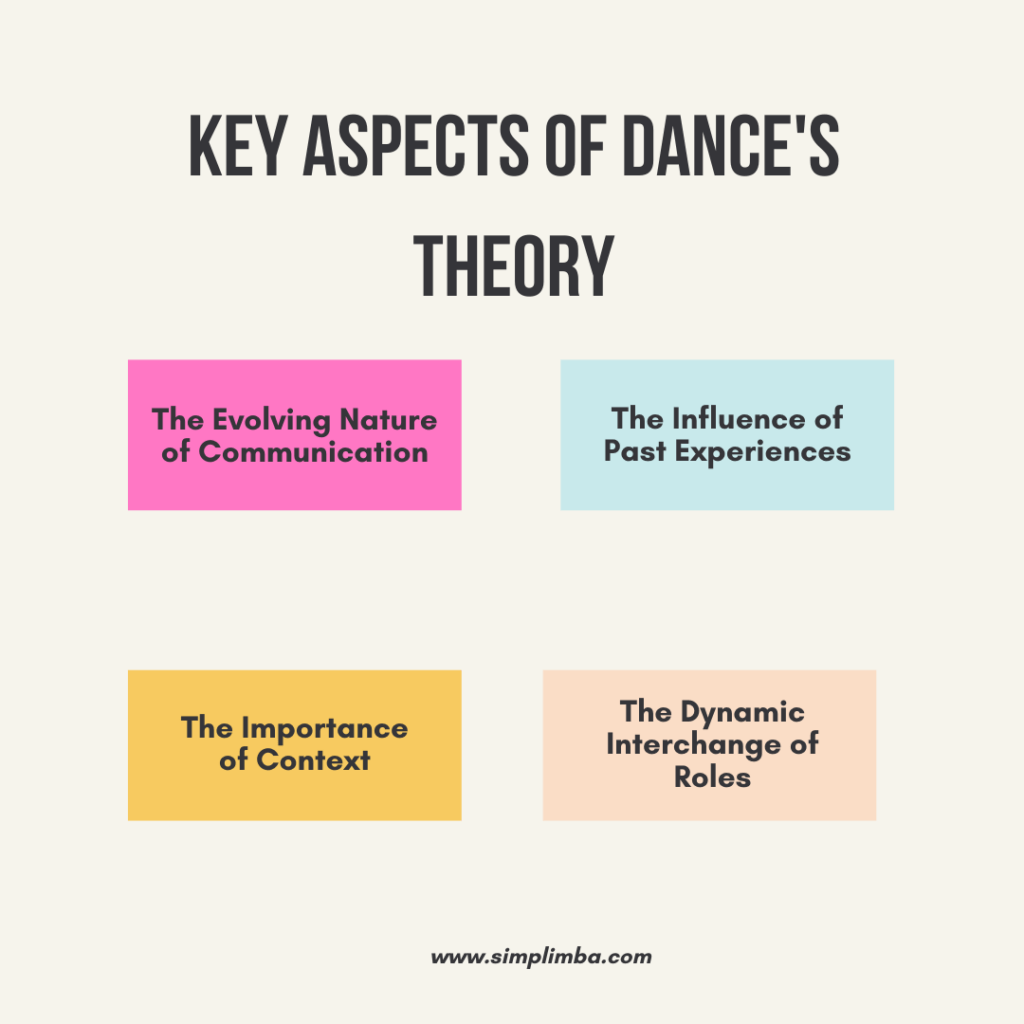
The Evolving Nature of Communication: One of the most significant elements of Dance’s theory is the concept that communication is not a one-time event or even a cyclic process, but rather an ongoing, evolving spiral. Each communication event influences, and is influenced by, the ones before it, gradually forming a spiral that grows wider and deeper with each interaction. This spiral is not necessarily symmetrical or uniform, reflecting the unpredictable and variable nature of communication.
The Influence of Past Experiences: Dance’s model posits that our past experiences shape our present and future communications. Every message we send or receive is interpreted based on our unique set of experiences, creating a subjective understanding that is continually enriched and expanded with each new interaction.
The Importance of Context: The helical model underscores the role of context in shaping communication. The model recognizes that each communication event takes place within a particular context, which influences how the message is interpreted and responded to. Like past experiences, context is seen as an integral part of the communication spiral, shaping and being shaped by the evolving communication process.
The Dynamic Interchange of Roles: Dance’s model acknowledges the dynamic interchange of roles in communication, recognizing that individuals continuously shift between the roles of sender and receiver. This flexible view of roles further underscores the model’s emphasis on communication as a continuous, interactive process.
5 Core Elements of Helical Model of Communication
Understanding the Helical Model of Communication requires delving into the core elements and factors that shape this dynamic process. At its heart, the model incorporates several key elements: the sender, the receiver, the message, the context, the continuous nature of communication, and the influence of past experiences.
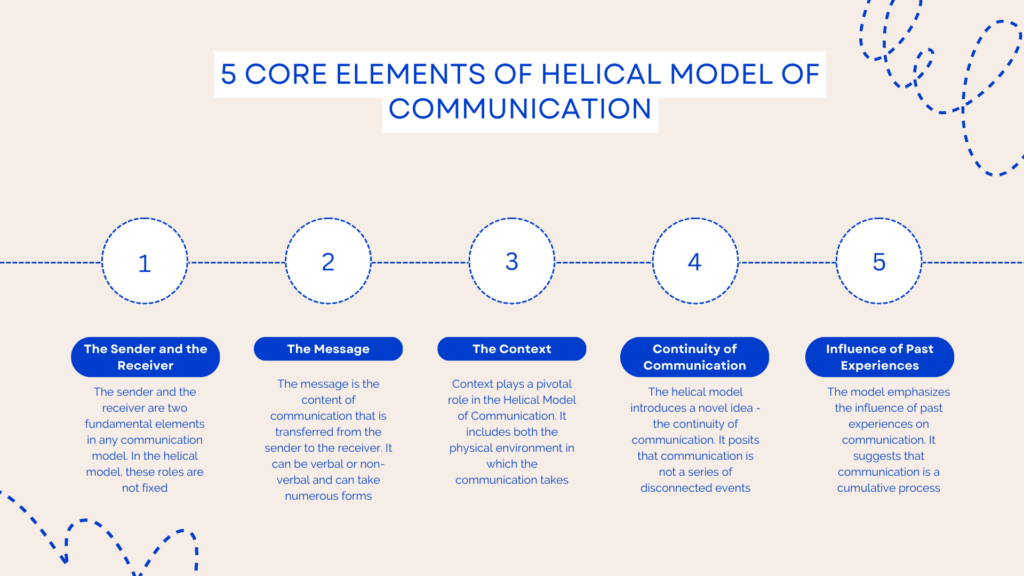
The Sender and the Receiver
The sender and the receiver are two fundamental elements in any communication model. In the helical model, these roles are not fixed; instead, they dynamically interchange as the conversation unfolds. Importantly, both the sender and receiver influence, and are influenced by, the communication process, emphasizing the interactive and reciprocal nature of communication.
The Message
The message is the content of communication that is transferred from the sender to the receiver. It can be verbal or non-verbal and can take numerous forms, including spoken or written words, gestures, facial expressions, or even silence. The unique aspect of the helical model is that it recognizes the interpretation of the message as a fluid process, influenced by the receiver’s past experiences and present context.
The Context
Context plays a pivotal role in the Helical Model of Communication. It includes both the physical environment in which the communication takes place and the broader social, cultural, and personal backgrounds of the communicators. The model underscores that the same message can carry different meanings based on the unique context of the receiver, thereby emphasizing the subjective nature of communication.
Continuity of Communication
The helical model introduces a novel idea – the continuity of communication. It posits that communication is not a series of disconnected events but a continuous, evolving process. Each interaction builds upon previous ones, influencing future communications, which creates a dynamic, iterative process of shared understanding and growth.
Influence of Past Experiences
The model emphasizes the influence of past experiences on communication. It suggests that communication is a cumulative process, where our understanding and interpretation of messages are informed by our prior experiences and knowledge. As such, every new interaction is a step in our ongoing communication journey, and our comprehension expands like an ascending helix.
In summary, the Helical Model of Communication’s core elements and factors represent a shift from traditional communication models. It presents a more complex, dynamic, and context-sensitive view of communication that mirrors real-life experiences, providing a deeper understanding of how we interact and make sense of the world around us.
Deep Dive into the Helical Model of Communication
In order to comprehend the full implications of the helical model, it’s crucial to delve into its nuanced aspects. This includes understanding the relationship between the sender and receiver, the role of context, and the model’s portrayal of communication as an evolving process
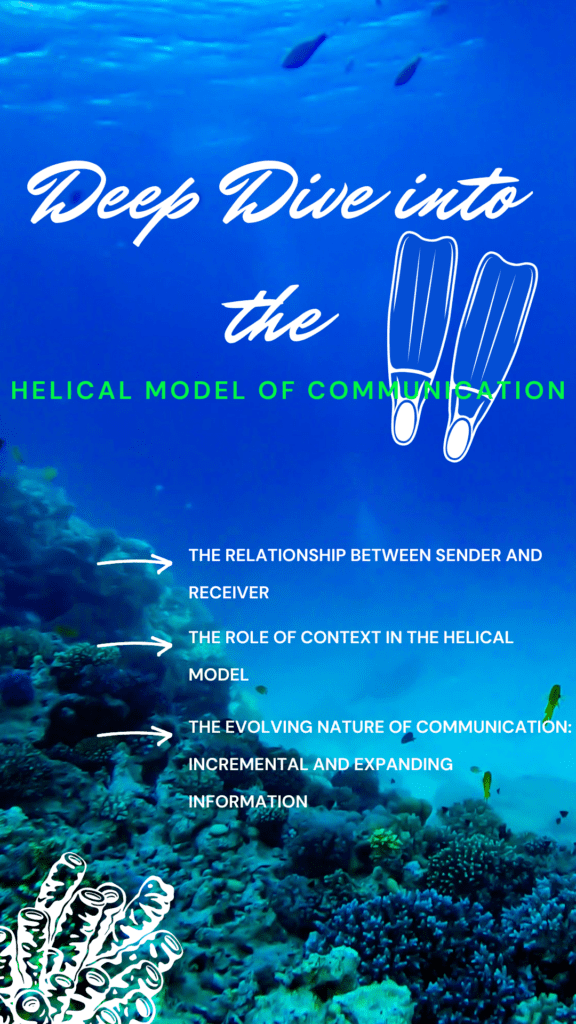
The Relationship Between Sender and Receiver
In the helical model, the sender and receiver are not static entities as found in more traditional models of communication. They are, instead, active participants in a continuous and dynamic process. Communication is not merely a matter of sending and receiving messages; it’s a complex, ongoing interaction that is influenced by past experiences and future expectations.
Every act of communication adds to the collective understanding between the sender and receiver, influencing future exchanges. This means that every communication event is both influenced by and an influencer of subsequent interactions, symbolizing the cyclical, interconnected nature of the communication process.
The Role of Context in the Helical Model
One of the distinguishing characteristics of the helical model is its strong emphasis on context. Context refers to the environment or background in which communication takes place, encompassing both the physical surroundings and the broader social, cultural, and personal background of the communicators.
The model posits that the same message can convey different meanings based on the receiver’s past experiences, existing knowledge, and current circumstances. This means the message’s interpretation is heavily dependent on the unique context of the receiver, which is continuously evolving and expanding.
The Evolving Nature of Communication: Incremental and Expanding Information
A fundamental tenet of the helical model is the concept that communication is an evolving process. Unlike traditional models, which depict communication as a linear or cyclic process, the helical model visualizes communication as an upward spiral that continually expands with each interaction.
This representation effectively illustrates how our understanding and knowledge incrementally expand with each communication event. As we progress through life, we accumulate experiences and knowledge, enriching our communication capacity. Hence, every new interaction is not just a singular event, but a cumulative step in the ongoing communication journey.
This perspective on communication allows us to appreciate how our interactions continually build upon prior ones, expanding and evolving in complexity and richness. The evolving nature of communication underscores that it is not just a means of exchanging information but a mechanism of shared understanding, growth, and transformation.
Differentiating the Helical Model from Other Models of Communication
| Focus Area | Linear Model of Communication | Interactive Model of Communication | Transactional Model of Communication | Helical Model of Communication |
| Direction of Communication | One-way flow from sender to receiver | Two-way process involving feedback | Simultaneous two-way process | Continuously evolving process |
| Feedback | No consideration for feedback | Includes feedback, but treats it as a secondary step | Integral part of communication, occurs simultaneously | Implicit in the continuous and iterative nature of communication |
| Role of Sender and Receiver | Distinct roles: sender sends, receiver receives | Sender and receiver roles can interchange | Sender and receiver roles are interdependent and interchangeable | Sender and receiver roles dynamically interchange |
| Influence of Past Interactions | No consideration for past interactions | Considers personal experiences, but doesn’t portray communication as evolving | Recognizes influence of past experiences but doesn’t explicitly portray communication as an evolving process | Fundamental; each interaction influences and is influenced by past interactions |
| Context | Minimal role, if any | Implicit in ‘field of experience’ but doesn’t strongly emphasize context | Emphasizes role of context in communication | Strong emphasis on the role of context in interpretation and meaning |
| Representation | Depicted as a straight line | Depicted as a cyclic process | Depicted as a dynamic, simultaneous exchange | Depicted as a continuously ascending helix |
Advantages and Strengths of the Helical Model
The helical model of communication, with its unique emphasis on the evolving and contextual nature of communication, boasts several strengths and advantages that set it apart from traditional communication models.
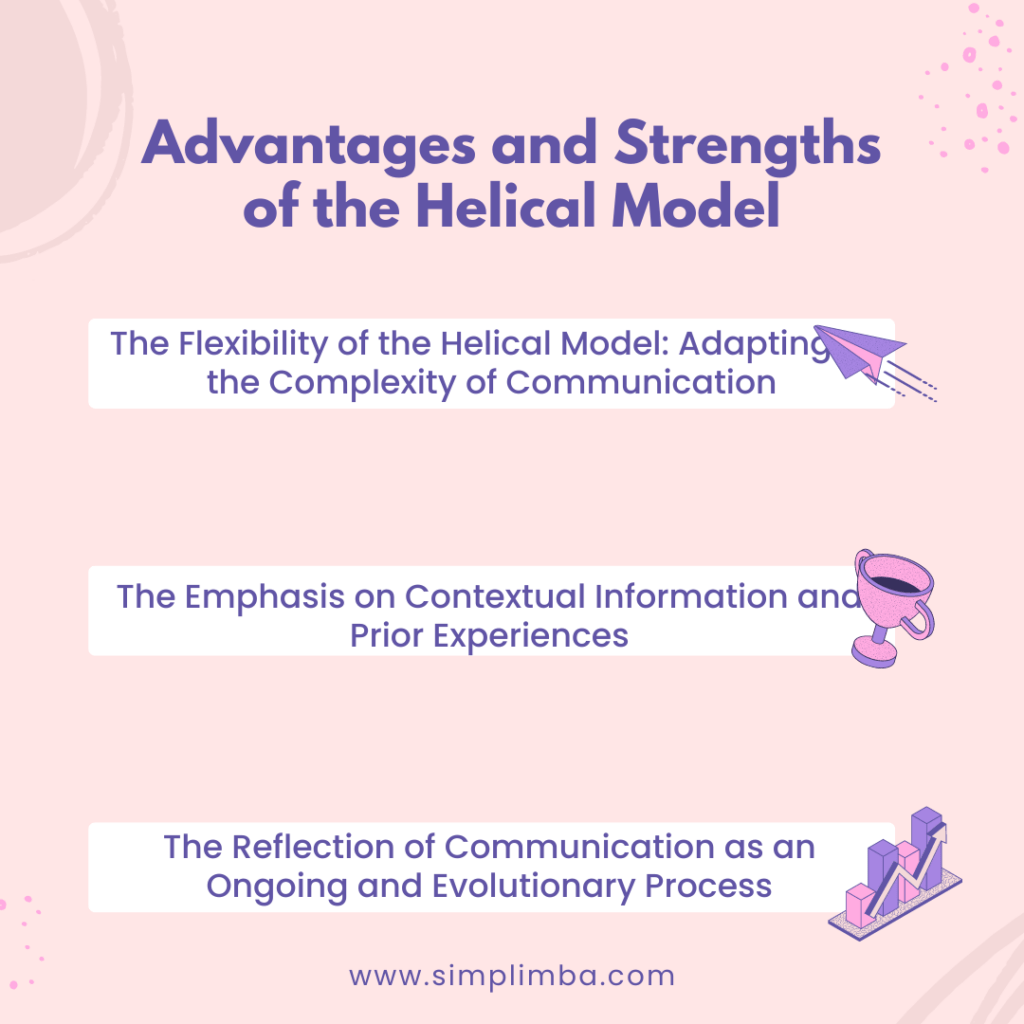
The Flexibility of the Helical Model: Adapting to the Complexity of Communication
One of the primary strengths of the helical model is its flexibility. This model is not confined by linear or cyclic depictions of communication, making it better suited to represent the complex, dynamic nature of human interaction. By illustrating communication as an evolving spiral, the model adeptly adapts to the complexities and variations in communication, accounting for changes in understanding and interpretation over time.
The Emphasis on Contextual Information and Prior Experiences
The helical model uniquely emphasizes the role of context and past experiences in shaping communication. It posits that every communication event is interpreted based on the receiver’s unique set of experiences and context. This perspective underscores the subjective nature of communication, reflecting the reality that the same message can carry different meanings for different people.
Moreover, by factoring in prior experiences, the model acknowledges that our past communications influence our present and future interactions. This recognition helps us appreciate how our communication capacity evolves and matures as we accumulate experiences and knowledge.
The Reflection of Communication as an Ongoing and Evolutionary Process
Perhaps the most distinctive strength of the helical model is its depiction of communication as an ongoing, evolutionary process. Unlike traditional models, which view communication as a series of discrete events, the helical model illustrates communication as a continuous spiral that grows broader and deeper with each interaction.
This representation effectively communicates the idea that our understanding and interpretation of messages are not static but continually evolving. Each new interaction builds upon previous ones, enriching our shared understanding and fostering growth. This unique perspective helps us appreciate communication as not merely an act of exchanging information but a process of shared learning and transformation.
Limitations and Critiques of the Helical Model
While the helical model of communication presents a nuanced view of communication, it is not without its limitations and critiques. Some of the key areas of critique include issues with visual representation and potential misinterpretation of continuous communication.
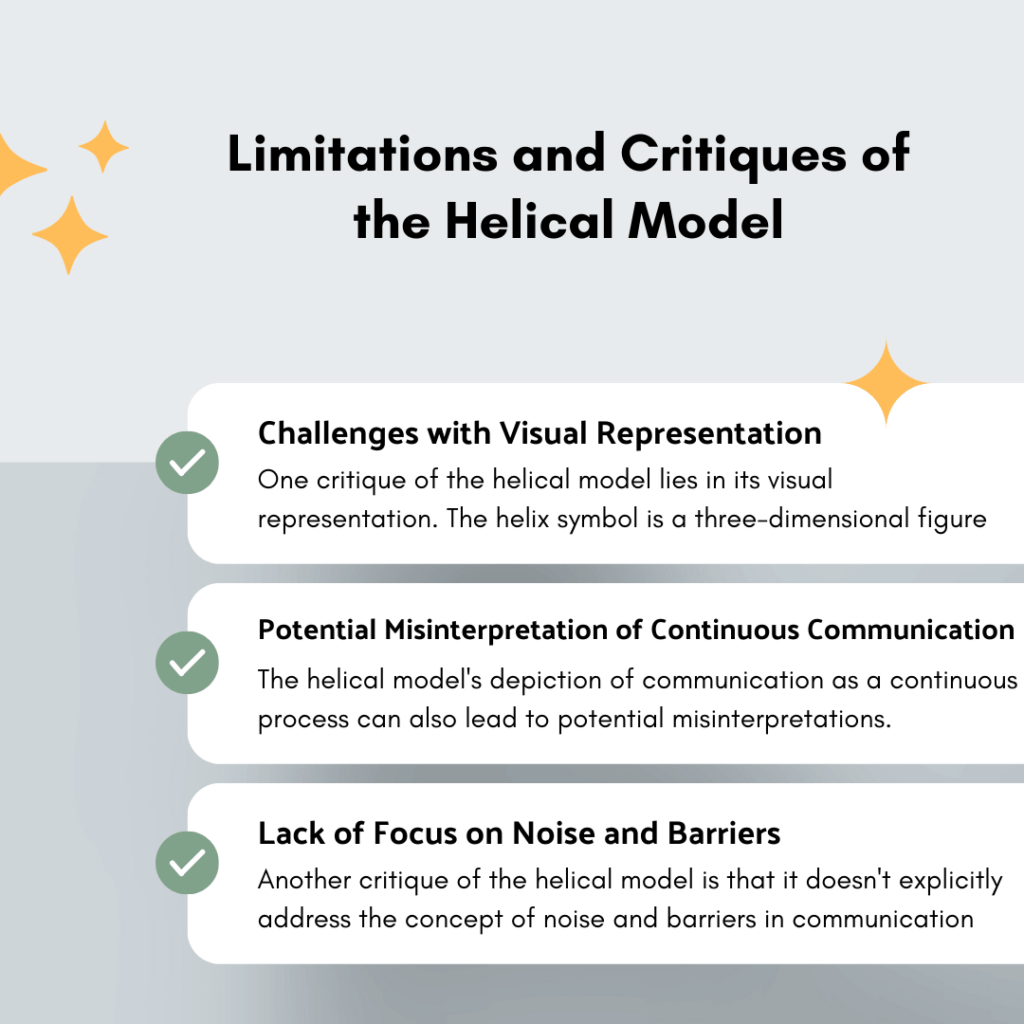
Challenges with Visual Representation
One critique of the helical model lies in its visual representation. The helix symbol is a three-dimensional figure, which can be challenging to depict accurately on a two-dimensional surface like paper or a computer screen. This might lead to misinterpretations or oversimplification of the model. Furthermore, while the helical representation captures the evolution and expansion of communication, it might not adequately represent the back-and-forth nature of interactive dialogues.
Potential Misinterpretation of Continuous Communication
The helical model’s depiction of communication as a continuous process can also lead to potential misinterpretations. While it’s true that our past experiences influence our present and future communications, it is not always the case that every interaction directly builds upon the last. In real-world scenarios, communication is often punctuated by interruptions, distractions, and disjointed exchanges that don’t necessarily follow a clear, ascending spiral.
Lack of Focus on Noise and Barriers
Another critique of the helical model is that it doesn’t explicitly address the concept of noise and barriers in communication, which can impede the communication process. Noise, in the context of communication models, refers to any form of disruption that distorts the message or interferes with the communication process. This could include physical noise, psychological noise (like stress or bias), and semantic noise (unclear language or jargon). By not addressing these potential obstacles, the helical model may offer an overly idealized view of communication.
Practical Applications of the Helical Model
The Helical Model of Communication is not just a theoretical construct, but it has numerous practical applications across various fields of communication including interpersonal communication, organizational communication, and mass communication.
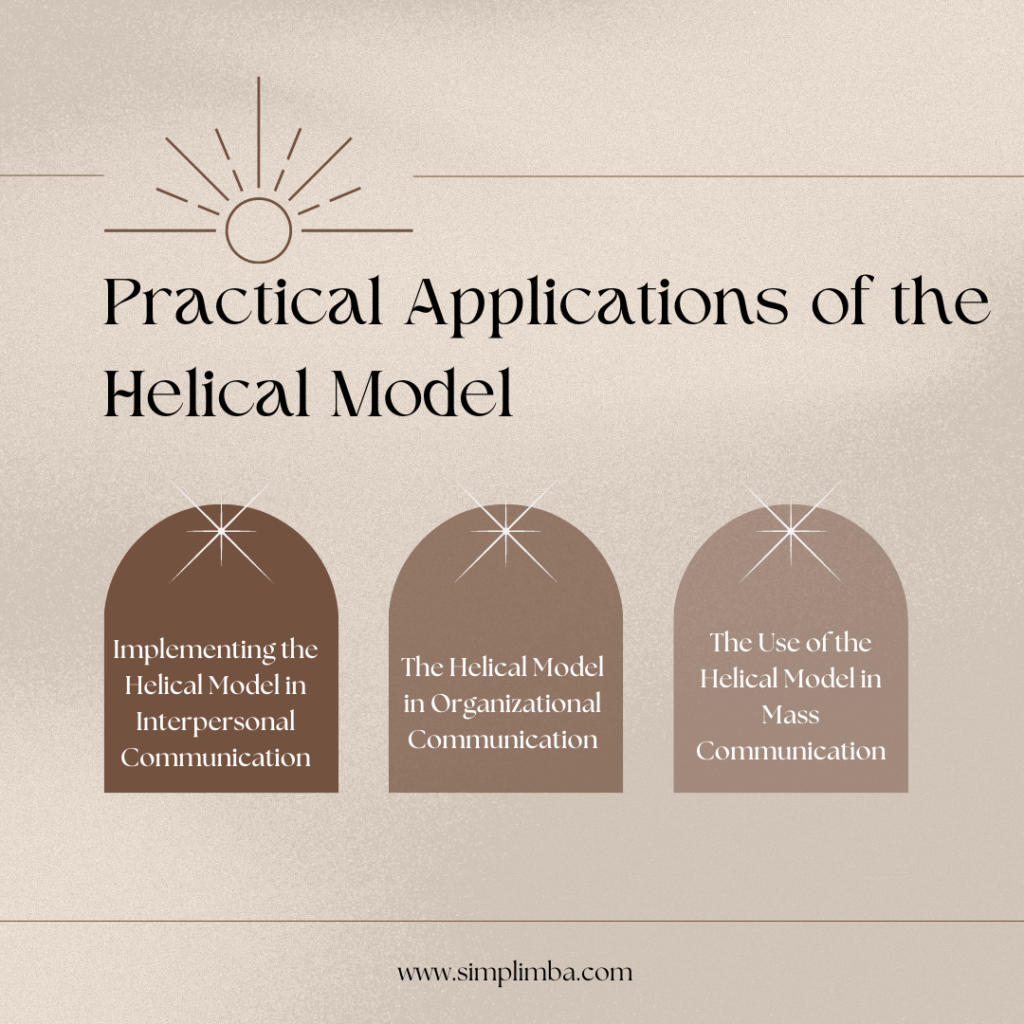
Implementing the Helical Model in Interpersonal Communication
In interpersonal communication, the helical model of communication can help individuals understand the evolving nature of their conversations. Recognizing that every exchange is informed by past interactions can lead to more thoughtful and effective communication. For instance, it encourages people to build on previous conversations, consider the other person’s context and experiences, and appreciate how their relationship evolves with each interaction.
The Helical Model in Organizational Communication
Organizations can also benefit from applying the helical model in their communication strategies. The model’s emphasis on the cumulative and evolving nature of communication can help organizations understand how shared knowledge and mutual understanding grow over time. This can be particularly beneficial for long-term projects, team-building initiatives, or any scenario where sustained, progressive communication is essential.
Additionally, the model’s emphasis on the importance of context and past experiences can help organizations tailor their messages more effectively. For instance, in internal communication, understanding employees’ past experiences and perceptions can help shape more meaningful, relevant messages.
The Use of the Helical Model in Mass Communication
In mass communication, such as advertising or public relations, the helical model of communication can offer valuable insights into audience perception and message design. Recognizing that every message is interpreted in the context of an individual’s past experiences can help advertisers and PR professionals craft messages that resonate more deeply with their audiences. Moreover, the model’s depiction of communication as a continuous, evolving process can guide strategies for sustained audience engagement.
In summary, the Helical Model of Communication, with its emphasis on the ongoing, evolving nature of communication and the importance of context and past experiences, offers valuable insights for improving communication practices in various fields. While the model does not capture the full complexity of communication, its principles can undoubtedly enhance our understanding and effectiveness in communicating.
The Future of Communication: Can the Helical Model Adapt?
As communication evolves, so too must our models and theories. The question then arises, can the helical model adapt to the future of communication?
The Helical Model and Digital Communication
With the advent of digital technology, the nature of communication has undergone significant changes. We now communicate across various digital platforms and mediums, from emails and social media to video conferencing and instant messaging.
Despite these changes, the core principles of the helical model of communication – the ongoing, iterative nature of communication, the importance of context, and the influence of past experiences – remain highly relevant. These principles can be applied to digital communication to understand how individuals interpret and respond to digital messages, how online interactions build upon previous ones, and how the context of the digital environment shapes communication.
Moreover, the helical model’s flexibility and emphasis on the evolving nature of communication make it well-suited to adapt to new forms of communication. As digital communication continues to evolve, the helical model can offer a valuable framework for understanding this dynamic process.
New Research Directions in Helical Communication
While the helical model of communication offers a valuable perspective on communication, there is much potential for further research and development. For instance, research could explore how the model applies to emerging forms of communication, such as virtual and augmented reality.
Additionally, research could delve into how the helical model of communication interacts with other factors that influence digital communication, such as algorithms and digital literacy. Understanding these interactions could help us refine the model and develop more nuanced theories of digital communication.
In conclusion, while the future of communication will undoubtedly bring new challenges and complexities, the helical model, with its emphasis on the evolving, context-dependent nature of communication, offers a strong foundation for understanding and navigating this dynamic landscape.
Conclusion
The Helical Model of Communication, proposed by Frank Dance, broke the confines of traditional linear and interactive models by portraying communication as an ongoing, evolving process that spirals out of past experiences and is influenced by the context. This revolutionary depiction brought fresh insights into the complexity and dynamism of human interaction.
The helical model of communication strengths lie in its flexibility, emphasis on contextual information, and the recognition of communication as an ongoing and evolutionary process. These attributes allow the model to adapt to various communication scenarios, offering a valuable framework for understanding interpersonal communication, organizational communication, and mass communication.
While the helical model of communication has its limitations, including challenges with visual representation and potential misinterpretations of continuous communication, its core principles remain highly relevant in our increasingly interconnected world. The model’s inherent adaptability and focus on the evolutionary nature of communication make it well-suited to embrace the future of communication, even in the rapidly evolving digital landscape.
Samrat is a Delhi-based MBA from the Indian Institute of Management. He is a Strategy, AI, and Marketing Enthusiast and passionately writes about core and emerging topics in Management studies. Reach out to his LinkedIn for a discussion or follow his Quora Page

